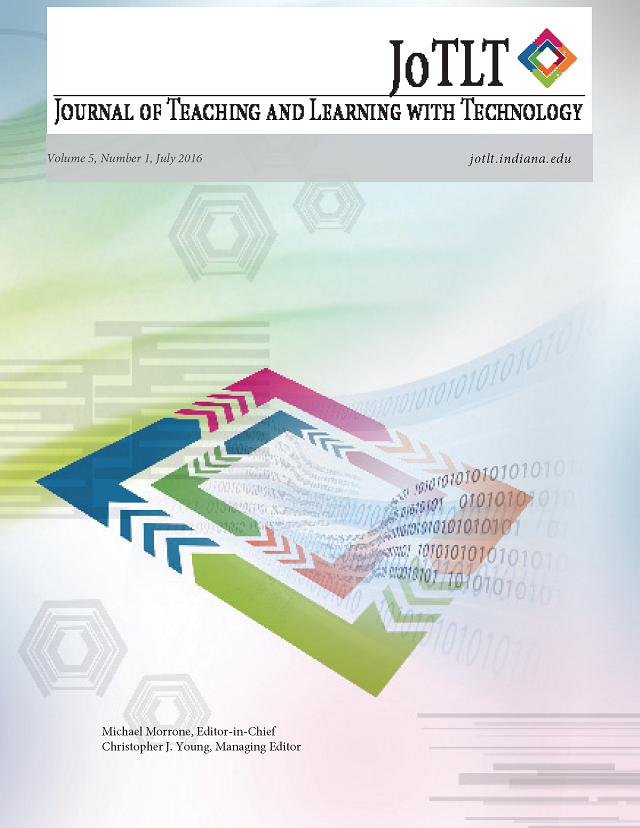Students’ and Instructor’s Attitudes and Receptions of the Viability of Using A Flipped Classroom Instructional Model In A Technology-Enabled Active Learning (TEAL) Classroom
Main Article Content
Abstract
Downloads
Article Details
- Authors retain copyright and grant the Journal of Teaching and Learning with Technology (JoTLT) right of first publication with the work simultaneously licensed under a Creative Commons Attribution License, (CC-BY) 4.0 International, allowing others to share the work with proper acknowledgement and citation of the work's authorship and initial publication in JoTLT.
- Authors are able to enter separate, additional contractual agreements for the non-exclusive distribution of the journal's published version of the work (e.g., post it to an institutional repository or publish it in a book), with an acknowledgement of its initial publication in JoTLT.
- In pursuit of manuscripts of the highest quality, multiple opportunities for mentoring, and greater reach and citation of JoTLT publications, JoTLT encourages authors to share their drafts to seek feedback from relevant communities unless the manuscript is already under review or in the publication queue after being accepted. In other words, to be eligible for publication in JoTLT, manuscripts should not be shared publicly (e.g., online), while under review (after being initially submitted, or after being revised and resubmitted for reconsideration), or upon notice of acceptance and before publication. Once published, authors are strongly encouraged to share the published version widely, with an acknowledgement of its initial publication in JoTLT.
References
Baxter, P. & Jack, S. (2008). Qualitative Case Study Methodology: Study Design and Implementation for Novice Researchers. The Qualitative Report, 13(4), 544-559.
Belcher, J. W. (2003). Improving Student Understanding with TEAL. The MIT Faculty Newsletter, 16(2), 1-10.
Breslow, L. (2010). Wrestling with Pedagogical Change: The TEAL Initiative at MIT. Change The Magazine of Higher Learning, 42(5), 23-29.
Cornelius, S. (2013). Facilitating in a demanding environment: experiences of teaching in virtual classrooms using web conferencing. British Journal of Educational Technology, 45(2), 260-271.
Davis, F. D. (1989). Perceived usefulness, perceived ease of use, and user acceptance of information technology. MIS Quarterly, 13(3): 319–340.
Davis, F. D. (1993). User Acceptance of Information Technology: System Characteristics, User Perceptions and Behavioral Impacts. International Journal of Man-Machine Studies, 38(3), 475487.
Davis, F. D., & Venkatesh, V. (1996). A critical assessment of potential measurement biases in the technology acceptance model: three experiments. International Journal of Human-Computer Studies, 45(1), 19-45.
Dori, Y. J., & Belcher, J. (2005). How Does Technology-Enabled Active Learning Affect Undergraduate Students’ Understanding of Electromagnetism Concepts. The Journal of the Learning Sciences, 14(2), 243-279.
Dori, Y. J., Belcher, J., Bessette, M., Danziger, M., McKinney, A., & Hult, E. (2003). Technology for active learning. Materials Today, 6(12), 44-49.
Edmunds, R., Thorpe, M., & Conole, G. (2012). Student attitudes towards and use of ICT in course study, work and social activity: A technology acceptance model approach. British Journal of Educational Technology, 43, 71–84.
Frydenberg, M. (2013). Flipping Excel. Information Systems Education Journal, 11(1), 63-73.
Gannod, G., Burge, J., & Helmick, M. (2008). Using the Inverted Classroom to teach Software Engineering Using the Inverted Classroom to Teach Software Engineering. Paper presented at The 30th International Conference on Software Engineering 2008. Leipsig, Germany.
Gehringer, E. F. & Peddycord, W. P. (2013). The Inverted-Lecture Model: A Case Study in Computer Architecture. Paper presented at Conference for Association for Computing Machinery's Special Interest Group on Computer Science Education 2013. Denver, CO.
Gerstein, J. (2011). The Flipped Classroom Model: A Full Picture. Retrieved from http://usergeneratededucation.wordpress.com/2011/06/13/the-flipped-classroom-model-a-fullpicture/
Heaney, R. & Arroll, M. (2010, September). Staff perceptions of second life. Paper presented at 20th Conference of the Association for Learning Technology, Nottingham.
Knewton (2012, March 8). The flipped classroom infographic: A new method of teaching is turning the traditional classroom on its head. Retrieved from http://www.knewton.com/flippedclassroom/
Lee, D. Y. & Lehto, M. R. (2013). User acceptance of YouTube for procedural learning: An extension of the Technology Acceptance Model. Computer & Education, 61, 193-208.
Makice, K. (2011, December 10). Flipping the Classroom Requires More Than Video. Retrieved from http://www.wired.com/geekdad/2012/04/flipping-the-classroom/
Merriam, S. (2009). Qualitative research: A guide to design and implementation. San Francisco, CA: Jossey-Bass.
Miller, A. (2012, March 7). Five best practices for the flipped classroom. Retrieved from http://www.edutopia.org/blog/flipped-classroom-best-practices-andrew-miller
O'Neil, K., Kelly, T. & Bone, S. (2012). We Turned Learning On Its Ear: Flipping the Developmental Classroom. In T. Amiel & B. Wilson (Eds.), Proceedings of World Conference on Educational Media and Technology 2012 (pp. 2752-2756). Association for the Advancement of Computing in Education (AACE).
Roca, J. C. & Gagne, M. (2008). Understanding e-learning continuance intention in the workplace: a self-determination theory perspective. Computers in Human Behavior, 24, 1585– 1604.
Szajna, B. (1996). Empirical Evaluation of the Revised Technology Acceptance Model. Management Science, 42(1), 85-92.
Shieh, R. S. (2012). The Impact of Technology-Enabled Active Learning (TEAL) Implementation on Student Learning and Teachers’ Teaching in a High School Context. Computer & Education, 59(2), 206-214.
Warter-Perez. N., & Dong. J. (2012, April). Flipping the Classroom: How to Embed Inquiry and Design Project into a Digital Engineering Lecture. Paper presented at American Society for Engineering Education-Pacific South West Section Conference, San Luis Obispo, CA.
Yin, R. K. (2003). Case study research: Design and methods (3rd ed.). Thousand Oaks, CA: Sage.
